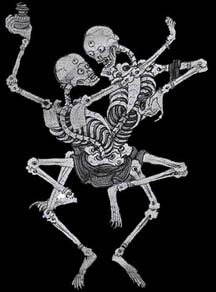Martial Arts: Apples and oranges
There are three basic types of human combat: competition (a game), fighting (a serious and potentially deadly game), self-defense (not a game, it involves defending your life and possibly taking a life), and warfare (definitely not a game, it involves killing as many of the enemy as you can before they kill you). The primary concern of the martial arts is combat, but not every martial art is concerned with all four types of combat. To be compared fairly, only arts that are concerned with the same type of combat should be compared. For example, it is not fair to compare a competition martial art, such as sport taekwondo, to a self-defense martial art such as Krav-Maga.
Comparisions
Each type of combat may be compared as to:
- Purpose. Each type of combat has a purpose. In competition, the purpose is to satisfy the need of humans to pit themselves against each to determine who is best at something. Competition combat allows people to compete often and satisfy their need to compete, since there is little risk of injuries that may prevent them from competing. Fighting has the same purpose as competition, but the combatants are people with little fear of being injured and their goal is to injure the opponent enough that he or she gives ups, is knocked unconscious, or is unable to continue. However, injuries limit the number of fights a combatant may enter, since, depending on the severity of the injury, the combatant must take time off to heal. The purpose of self-defense is self-preservation. The victim must defend and counterattack to protect his or her well-being or life. The purpose for warfare is to allow a group or country to gain power over another group or country and force it to cease its attacks or to comply with the will of the victorious country.
- Choice. In each type of combat, the combatants have a choice of whether or not to enter into combat. In competition, both opponents voluntarily enter into combat and each may withdraw from the competition at any time. Initially, in a fight, both combatants voluntarily enter into combat, since both have the option of leaving without fighting. However, when one combatant wants to leave but is not allowed to leave, then he or she must either fight back or face injury or possibly death. In self-defense, the attacker chooses to attack the victim and, like it or not, the victim has no choice must defend and fight back or face serious injury or death. In warfare, each side may or may not have a choice as to whether or not to enter into war; circumstances sometimes make war inevitable.
- Rules. Each type of combat has rules. Competition has written rules that are completely understood by each opponent and are enforced by a third person. Fighting has no written rules, but, depending on the culture of the combatants, there are unwritten rules, which may or may not be completely understood by both combatants and which may not be adhered to by both combatants. These rules may be enforced by bystanders who believe the combatants should adhere to the rules. Self-defense has no rules except for some limitations placed upon it by law. The law does not matter to an attacker, and it will probably not be considered by an untrained defender, maybe not even by a trained defender, while in the heat of battle. In warfare, there are the rules of war set forth by the Geneva Convention, but abiding by the rules is voluntary.
- Goal. Each type of combat has a goal. In competition, the goal is to defeat the opponent under the established rules, using permitted techniques. In fighting, the goal is defeat the opponent using any technique permitted by the unwritten rules, but, since the rules are not enforced, an opponent may use any technique he or she wants to use. In self-defense, the goal of the attacker is to seriously injure or kill the victim, and the goal of the victim is to defend against the attack and stop the attacker from attacking or to convince the attacker to stop attacking. The purpose of warfare is to kill as many of the enemy and destroy as much of the enemy’s infrastructure as necessary to achieve its compliance, surrender, or defeat.
- Legal Techniques. Each type of combat has “legal” methods and permitted techniques that may be used to “win.” In competition, these methods and techniques are clearly defined. The methods and techniques permitted are designed to protect the opponents from serious injury while still allowing for the determination of a winner. In a fight, the permitted methods and techniques used are those that allow a combatant to “beat” the opponent. Since there is no enforcement of the rules, illegal techniques may be used. A win occurs when the opponent is unable or unwilling to continue the fight. The techniques used may or may not be deadly, but either way, the risk of serious injury or death is always present. In self-defense, the attacker will use any way possible to seriously injure, incapacitate, or kill the victim; the attacker has no legal limitations. However, the victim is legally bound to use only the amount of force necessarily to stop the attack. The victim is not legally permitted to attack the attacker after the attack has ceased. In warfare, there are commonly accepted methods and techniques that may be used, such as shooting or bombing, but some methods are almost universally condemned, such as nerve gas and torture.
How martial arts relate to combat
- Systems and styles of martial arts are specifically designed to be used in one or more of these types of combat. Although not specially designed for other types of combats, the methods and techniques of most martial arts may be used in all types of combat.
- Some martial arts are designed for competition, such as taekwondo and Karate, where techniques must be technically perfect and controlled. With a change in range and attitude, their methods and techniques may be used effectively in fighting and self-defense, and possibly in warfare.
- Some martial arts are designed for fighting, such as Street MMA and kick boxing, where techniques need not look good, just be effective. Although watered down versions of this arts are used in competition, the hard versions are effective in fights. These techniques may be effective for self-defense and warfare, but locks and pins can be troublesome under these conditions.
- Some martial arts are designed for self-defense, such as Krav-Maga and Keichu-do, where techniques are not pretty; they down and dirty, using such techniques as eye gouges, bites, head butts, and finger breaks. Self-defense techniques cannot be used in competition, but they may use used in fighting, and should be used in warfare.
- Some martial arts are designed for warfare, such as the United States Marine Corps LINE System or its MCMAP, were techniques are meant to kill the opponent. These techniques cannot be used in competition, but could be used in fighting and self-defense. Hand-to-hand combat in the military is mainly used in peacekeeping activities, similar to police duties. Soldiers on the battlefield do not have time for hand-to-hand fighting. When used in war, martial arts are used to keep a soldier alive until a buddy can shoot the attacker. Soldiers do not have a lot of time to train in a martial art, it is only one of many things in which they must be proficient.
Conclusion
All martial arts are good at the type of combat what they were intended for, but none is good at all types of combat. Thus, comparing one martial art to another is similar to comparing apples to oranges


